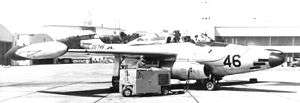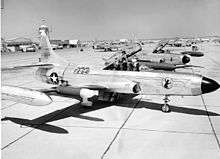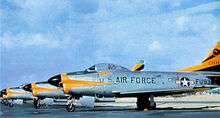566th Air Defense Group
The 566th Air Defense Group is a disbanded unit of the United States Air Force. Its last assignment was with the 28th Air Division at Hamilton Air Force Base, California where it was inactivated on 18 August 1955. The group was originally activated as a support unit for a combat group at the end of World War II but never deployed before it was inactivated in 1945.
566th Air Defense Group
 | |
|---|---|
 Cannon armed F-89 of the 84th FIS at Hamilton AFB | |
| Active | 1944–1945; 1952–1955 |
| Country | |
| Branch | |
| Type | Fighter Interceptor |
| Role | Air Defense |
| Part of | Air Defense Command |
The group was activated once again in 1952 to replace the support elements of the inactivating 78th Fighter-Interceptor Wing. A year later ADC established it as an operational headquarters for fighter-interceptor squadrons as well. It was replaced in 1955 when ADC transferred its mission, equipment, and personnel to the 78th Fighter Group in a project that replaced air defense groups commanding fighter squadrons with fighter groups with distinguished records during World War II.
History
World War II
The group was activated at Robins Field, Georgia toward the end of World War II as the 566th Air Service Group in 1944 and trained to support a single combat group.[1] Its 984th Air Engineering Squadron[2] would provide maintenance that was beyond the capability of the combat group, its 1004th Air Materiel Squadron[2] would handle all supply matters, and its Headquarters & Base Services Squadron would provide other support.[1] The group was inactivated before it could be deployed overseas.[3] It was disbanded in 1948.[4]
Cold War
During the Cold War the group was reconstituted, redesignated as the 566th Air Base Group, and activated at Hamilton Air Force Base, California in 1952[5] in a major reorganization of Air Defense Command (ADC) responding to ADC's difficulty under the existing wing base organizational structure in deploying fighter squadrons to best advantage.[6] It replaced the 78th Air Base Group as host unit for Hamilton. The 566th was assigned eight squadrons and one flight to perform its support responsibilities.[7][8][9][10] The group also assumed responsibility to maintain aircraft stationed at Hamilton from the inactivating 78th Maintenance & Supply Group,[11] while the operational elements of the 78th Fighter-Interceptor Wing[12] were assigned to the 28th Air Division.


The 566th was redesignated the 566th Air Defense Group[5] and assumed responsibility for air defense of the Northern California. It was assigned the 84th Fighter-Interceptor Squadron (FIS), flying 20mm cannon armed and airborne intercept radar equipped Northrop F-89 Scorpion aircraft[13] from the 28th Air Division as its operational element.[14] The 84th FIS was already stationed at Hamilton.[14] In March, a second operational squadron, the 496th Fighter-Interceptor Squadron, was activated at Hamilton and assigned to the group.[15]
The 496th FIS was initially equipped with outmoded World War II era North American F-51 Mustang Aircraft.[16] In April, the 83rd FIS traded its Scorpions for Lockheed F-94 Starfire aircraft.[13] and to later model Starfire, armed with Mighty Mouse rockets, before the end of the year.[13] The 496th FIS, in turn, converted to North American F-86 Sabres (also with radar and Mighty Mouse rockets) during 1953.[16] In February 1954, the 325th Fighter-Interceptor Squadron at Travis Air Force Base, California, also flying Sabres,[17] was assigned to the group.[18] Ten days after its assignment, the 325th FIS moved from Travis to Hamilton.[18] A few months later, in July, the group once again had only two operational squadrons when the 496th FIS transferred to Europe and was assigned elsewhere.[15]
The 566th was inactivated[5] and replaced by the 78th Fighter Group (Air Defense) on 18 August 1955[19] as result of ADC's Project Arrow, which was designed to bring back on the active list the fighter units which had compiled memorable records in the two world wars.[20] The group was disbanded once again in 1984.[21]
Lineage
- Constituted as 566th Air Service Group in 1944
- Activated on 7 December 1944[2]
- Inactivated on ca. 14 August 1945
- Disbanded on 8 October 1948
- Reconstituted and redesignated as: 566th Air Base Group on 1 January 1952
- Activated on 1 February 1952
- Redesignated as 566th Air Defense Group on 16 February 1953
- Inactivated on 18 August 1955
Assignments
- Warner Robins Air Technical Service Command, 7 December 1944 – ca. 14 August 1945[2]
- 4702d Defense Wing, 1 February 1952[5]
- 28th Air Division 7 November 1952 – 18 August 1955[5]
Stations
- Robins Field, Georgia, 7 December 1944 – ca. 14 August 1945
- Hamilton Air Force Base, California, 1 February 1952 – 18 August 1955
Components
Operational Squadrons and Flight
- 84th Fighter-Interceptor Squadron, 16 February 1953 – 18 August 1955[22]
- 325th Fighter-Interceptor Squadron, 1 February 1954 – 18 August 1955
- 496th Fighter-Interceptor Squadron, 20 March 1953 – 1 July 1954
- 13th Crash Rescue Boat Flight, 7 November 1952 – 18 August 1955
Support Squadrons
|
|
Aircraft
- North American F-51D Mustang, 1953
- North American F-86D Sabre, 1953–1954
- North American F-86E Sabre, 1954–1955
- Northrop F-89B Scorpion, 1953
- Lockheed F-94B Starfighter, 1953
- Lockheed F-94C Starfighter, 1953–1955
Commanders
- Lt Col. Charles E. Stiven, 7 December 1944 – ca. April 1945[2]
- Lt Col. Charles W. Coleman, ca. April 1945 – ca. 14 August 1945
- Unknown 1952 – 1955
See also
- Aerospace Defense Command Fighter Squadrons
- List of F-86 Sabre units
- F-89 Scorpion units of the United States Air Force
- F-94 Starfire units of the United States Air Force
References
Notes
- Coleman, p. 208
- "Abstract, History 566 Air Service Group Dec 1944". Air Force History Index. Retrieved 17 June 2012.
- Coleman, p. 215
- Department of the Air Force Letter, 322 (AFOOR 887e), 8 October 1948, Subject: Disbandment of Certain Inactive Air Force Units
- Cornett & Johnson, p. 84
- Grant, p. 33
- Cornett & Johnson, p. 134
- Cornett & Johnson, p. 151
- See "Abstract, History 566 Medical Squadron Jan–Jun 1953". Air Force History Index. Archived from the original on 2 March 2014. Retrieved 17 June 2012.
- See "Abstract, History 566 Food Service Squadron Feb–Mar 1952". Air Force History Index. Retrieved 17 June 2012.
- Cornett & Johnson p.141
- Kane, Robert B. (4 February 2010). "Factsheet 78 Air Base Wing (AFMC)". Air Force Historical Research Agency. Archived from the original on 27 September 2015. Retrieved 17 April 2012.
- Cornett & Johnson, p.120
- Maurer, Combat Squadrons, p. 293
- Maurer, Combat Squadrons p. 598
- Cornett & Johnson, p. 130
- Cornett & Johnson, p. 126
- Maurer, Combat Squadrons, p.400-401
- Maurer, Combat Units, p. 143
- Buss, Sturm, Volan, & McMullen, p.6
- Department of the Air Force/MPM Letter 575q, 27 September 1984, Subject: Disbandment of Units
- Bailey, Carl E. (8 March 2010). "Factsheet 84 Flying Training Squadron (AETC)". Air Force Historical Research Agency. Retrieved 11 September 2012.
- See "Abstract, History 19 WAF Squadron Apr–Jun 1952". Air Force History Index. Retrieved 17 June 2012.
- See "Abstract, History 566 and 78 Hospitals Jul–Dec 1955". Air Force History Index. Archived from the original on 4 March 2016. Retrieved 17 June 2012.
Bibliography
![]()
- Buss, Lydus H.(ed), Sturm, Thomas A., Volan, Denys, and McMullen, Richard F., History of Continental Air Defense Command and Air Defense Command July to December 1955, Directorate of Historical Services, Air Defense Command, Ent AFB, CO, (1956)
- Coleman, John M (1950). The Development of Tactical Services in the Army Air Forces. New York, NY: Columbia University Press.
- Cornett, Lloyd H; Johnson, Mildred W (1980). A Handbook of Aerospace Defense Organization, 1946–1980 (PDF). Peterson AFB, CO: Office of History, Aerospace Defense Center.
- Grant, C.L., (1961) The Development of Continental Air Defense to 1 September 1954, USAF Historical Study No. 126
- Maurer, Maurer, ed. (1983) [1961]. Air Force Combat Units of World War II (PDF) (reprint ed.). Washington, DC: Office of Air Force History. ISBN 0-912799-02-1. LCCN 61060979.
- Maurer, Maurer, ed. (1982) [1969]. Combat Squadrons of the Air Force, World War II (PDF) (reprint ed.). Washington, DC: Office of Air Force History. ISBN 0-405-12194-6. LCCN 70605402. OCLC 72556.
Further reading
- Leonard, Barry (2009). History of Strategic Air and Ballistic Missile Defense (PDF). Vol I. 1945-1955. Fort McNair, DC: Center for Military History. ISBN 978-1-4379-2131-1.
